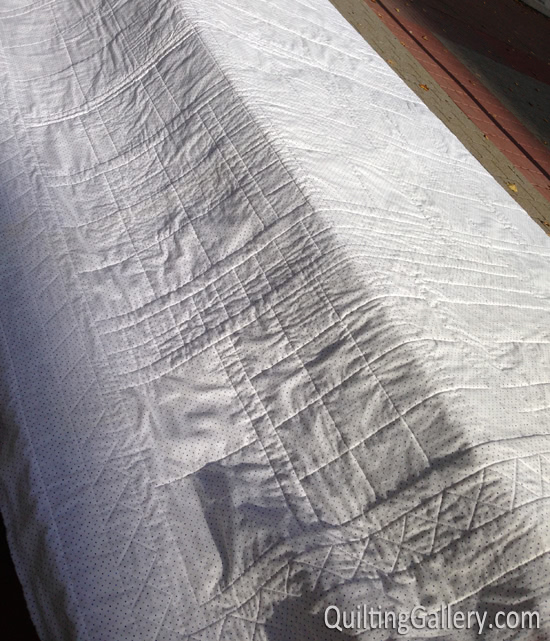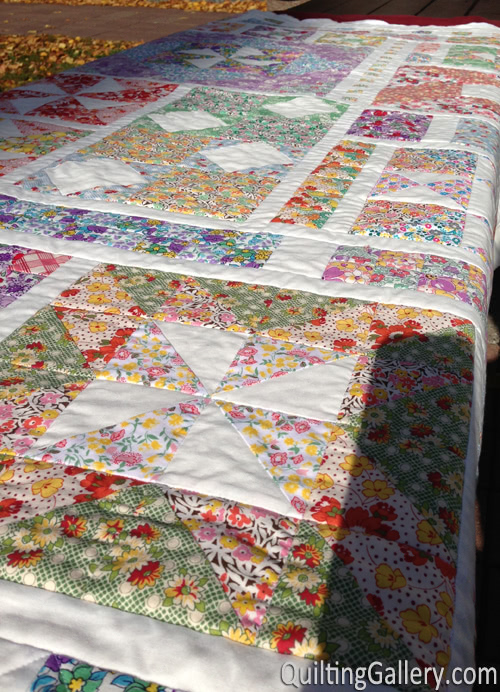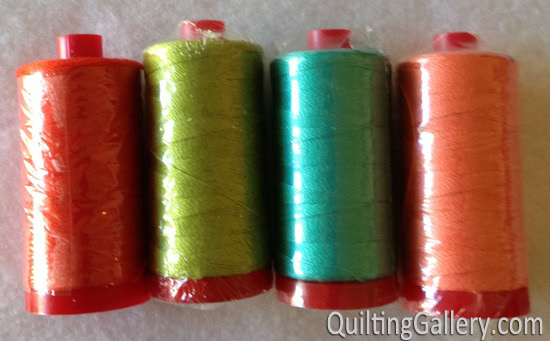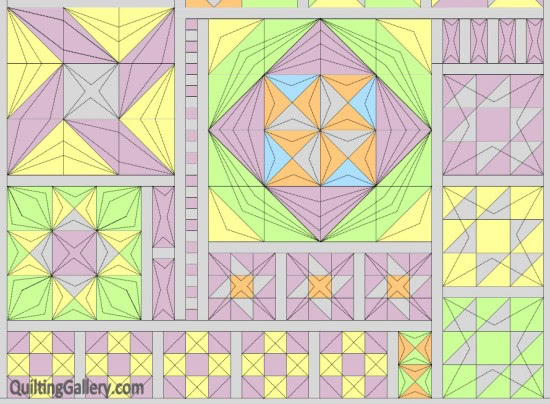The Aiming for Accuracy quilt-along (QAL) was held in the Summer/early Fall of 2013. The lessons, blocks and detailed photo tutorials have been removed from this site and are now available for sale as a complete booklet.
Find out more about it here: Aiming for Accuracy Booklet.
Now that your Aiming for Accuracy quilt top is complete, I want to share some ideas and resources for further information on completing your quilt.
The four main tasks to transform your top into a finished quilt are choosing batting, basting, quilting and binding. Let’s look at each one.
Choosing Batting
Before you can baste your quilt top, you’ll need to decide on what kind of batting you want to use. I don’t have a tonne of experience with different types of batting and have only worked with 100% cotton, cotton/poly blends and 100% poly. I have yet to try silk, wool, bamboo, etc. Generally speaking, I prefer cotton, as I like the way the washed quilt crinkles. I usually purchase my batting when it’s on sale locally, at large quilt shows where I can get great deals and talk to the manufacturers, or at large box stores in the States.
Of the brands I’ve tried so far, I really like Quilters’ Dream Batting (cotton and poly), Warm and White, and Legacy by Pellon. I prefer a batting that is needle-punched as opposed to being fluffy and lofty.
As I quilt my own quilts on my domestic machine, for large quilts, I choose a thinner batting, such as a Request weight by Quilters’ Dream. I find it much easier to manipulate the bulk under my machine. For wall hangings and table runners, I really like the thickness and stability of Warm and White.
Some tips:
- Choose a good quality batting. Feel it! Do you like how it feels? Does it have little bits of cotton stems left in it? Does it pull apart and separate when you tug it lightly?
- You need to know how you will be quilting your finished project as battings have ratings that indicate how far apart the quilting lines should be. These are important and it’s been my experience that some battings that say you can quilt 10″ apart, hold up much better with more quilting than recommended.
- Try different brands and types of batting. Don’t be afraid to experiment.
- Consider the washability of the item. I always use batting that can be washed and dried by machine, but you may want to experiment with some other types (such as wool) that will need special consideration.
- If you plan to hand quilt, definitely choose a batting that has been made specifically with that in mind. Ask around for recommendations.
Further reading:
Basting
Basting is the process of temporarily holding together the three layers of your quilt sandwich while you are quilting. There are four main ways to baste: spray baste, pin baste, hand baste with thread or to use a fusible batting.
I prefer to spray baste and highly recommend June Tailor’s Basting Spray. For small projects, I’ll spray outside but for larger projects, I spray inside with all the windows wide open.
Further reading/viewing:
- How to Spray Baste Your Quilt – this is generally how I do mine, except that I do all work on my table, not the floor.
- Video: Sharon Schamber Hand Basting
- Video: Patsy Thompson Spray Basting
- Making the Quilt Sandwich by Elizabeth Hartman
Quilting
To me, the actual quilting part of the process of making a quilt is very personal. It can be an entire exploration in design. I often feel that a quilt will speak to me in how to quilt it. I know that sounds weird, but for me, it’s true.
For the 1930s version of this quilt, I have chosen to first stitch in the ditch all sashing and main block pieces. This was not a quick process, but I thought it was needed to support the batting I chose to use and the free motion quilting I plan to add. As of writing this, I have completed all of the stitch in the ditch work and am now ready to move on to the free motion magic.

I’m just starting to see the crinkly effect of the 100% cotton batting:

The next step for me will be to do the free motion. I played around with design options in my drawing program. Below is a portion of the final idea I will be transferring to the quilt top. I only did 1/2 of the quilt, as I found that the perspective of working in the drawing program vs. the actual quilt wasn’t the same, and more quilting lines will be required when I actually draw out the design on my top. You can click the photo for a close-up.
For the quilt-along version, I will be stitching in the ditch as I did for the 1930s version with an invisible thread and then hand quilting 1/4″ away from all seams with 12wt. Aurifil thread.

This will be my second hand quilted project. The first was just a mini quilt, and I realize this will probably take me ages, but it will be so worth it in the end. I got hooked on this technique by Sarah Fielke’s awesome video:
Below are various resources for you to explore the quilting process. This is a huge topic, and could be, and has been by others, a quilt-along on its own. These should get you started:
- The Free Motion Quilting Project by Leah Day
- Patsy Thompson’s Free Motion Quilting
- Sharon Schamber videos
- Free Motion Quilting Tutorials by The Inbox Jaunt
- Big Stitch Quilting with Ana Marie Horner
- From Lenna Green: Perfect Hand Quilting Without Pain and Tips for Beginning Hand Quilting
- 31 Days of Walking Foot Quilting
Binding
For the binding of my 1930s quilt, I cut 2.5″ strips from the various fat quarters that I used in the top. The backing of this quilt is a solid piece, so I had enough FQ fabric left to cut the 17 strips needed. For the quilt-along version, I am using the same yardage as the checker board border.
I always stitch my binding on the front of my quilt by machine and then hand stitch the back. Sure, it takes a lot longer than machine quilting, but it’s my preferred method. I find doing those final stitches by hand to be most relaxing.
There are numerous binding tutorials available. Here are my favourites:
- Award winning quilter, Sharon Schamber, shares video tutorials of her binding technique using Elmer’s school glue. I learned the most on how to get beautiful binding from these series of videos. However, I rarely glue my bindings as I found that step to be rather time-consuming and unnecessary for my quilts as they are meant to be loved, not entered into a show.
- Machine Binding Tutorial by Pat Sloan.
- Julie Herman from Jaybird Quilts has a great series of posts on binding basics
- Very detailed tutorial by Dana of Old Red Barn Co. – How to Bind a Quilt
- More video tutorials from Sharon Schamber on curved binding
That’s it for me. Lots and lots of resources to keep you busy. Remember, there is no ONE WAY that’s right to do anything in quilting. Always keep learning and trying new ideas.
Have fun finishing your quilts. Please do share your finished photos in our Facebook Group. I can’t wait to see them.



Thanks Michelle, I am looking forward to doing mine up…
Hugz
Michele, I just want to tell you …you are awesome!! I have been quilting for quite a long time, and you taught me a lot. Thank you very much.
I am not yet finished, but I know I love my quilt.
I started doing two colors, stopped one , as I decided I wanted to concentrate on one at a time. I will complete the second , and I can already say I know I will love it too. Thank you, doesn’t seem enough to say.
You are AWESOME :)
I want to thank you for this quilt along. I have just started mine and will miss the prize portion but I think I will be handsomely rewarded with more awareness in what I am doing. Being self taught with books only takes you so far. I learned quite a few things reading and trying samples parts to make sure I understood. Your teaching skills are to be applauded. Thank you again for taking the time to share such a bounty of information with us.
I look forward to your next lesson in paper piecing. I have read a little about it, but have no idea how to do it.
I really enjoyed this quilt along. Stitched mine from left over hand dyed and or painted fabric that I had done for other projects over the years. Sorry to say no photo’s available as camera broken. Am very pleased with result so far. Have started to hand quilt with bamboo batting. Will take me about 4 months if I quilt for an hour a day. As I live in the tropics and it is heading towards a long, hot summer I Have to put the aircon on positively arctic so I can only do this when I am home alone. Thanks for all the tips etc. you shared along the way.